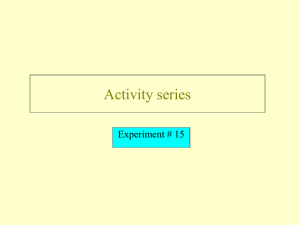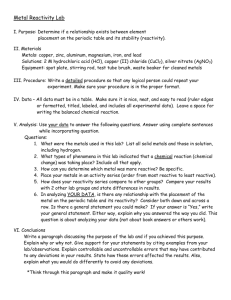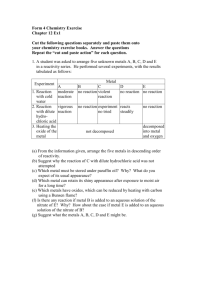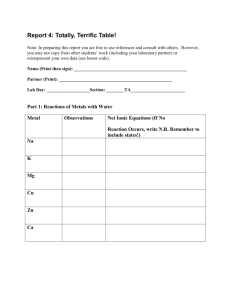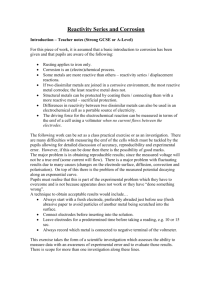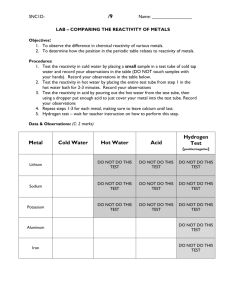Equivalent Weight of Magnesium
advertisement
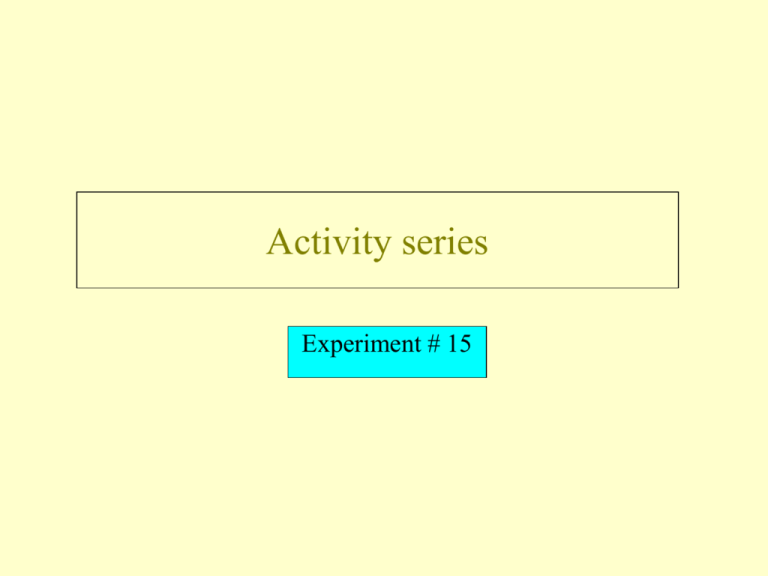
Activity series Experiment # 15 What we are doing today: • We are going to test reactions of metals with acids • We are going to test single replacement reactions. •We are going to determine a relative activity series BASED ON OUR EXPERIMENTAL DATA 9F Reactivity in chemistry What does reactivity mean? Elements that are reactive readily take part in reactions with other chemicals. To compare the reactivity of different elements, we might see how easily they react with oxygen. Some metals corrode in minutes out on the bench. Others take longer to corrode, unless you heat them. 9F The Gold Cup again? We can list metals in order of how quickly they react with oxygen. This ranking of metals according to reactivity is called the reactivity series. Ca Element Reactivity Li Rb K Ba Ca Na Mg Al Mn Zn Cr Fe Ni Sn Pb H2 Cu Hg Ag Pt Au Halogen Reactivity F2 Cl2 Br2 I2 9F Reaction of metals with acid What if we react different metals with acid? copper iron lead magnesium sodium –– the the –– no the metal metal –bubbles, metal the reacts reacts metal bursts no slowly, very reacts reaction into slowly, producing flames, quickly with producing acid with a very a few thestrong very bubbles acid,few reaction bubblesproducing lots of bubbles 9F Feeling a bit displaced? A single replacement reaction happens when one metal replaces another one in a compound. Magnesium is more reactive than copper. Magnesium displaces copper from copper sulphate solution. magnesium + copper sulphate magnesium sulphate + ? 9F A model for displacement reactions This model will help explain displacement reactions. Think of reactivity as aggression! Write a word equation for this reaction. Activity series • The higher up in the chart, the more reactive the metal. • Only metals higher on the chart can displace a metal below it Fe II (s) + 2CuSO4 (aq) 2Cu(s) + Fe(SO4)2 (aq) Element Reactivity Li Rb K Ba Ca Na Mg Al Mn Zn Cr Fe Ni Sn Pb H2 Cu Hg Ag Pt Au Halogen Reactivity F2 Cl2 Br2 I2 Part A • To six test tubes add approximately 0.5 ml of HCl • Add a small piece Ca metal to the test tube • Record all changes • Repeat for all five metals • Write complete and ionic equations for each metal Part B • To one test tube add approximately 0.5 ml of a polyatomic ionic compound Ca(NO3)2 • Repeat for each of the other six polyatomic ionic compounds • Add a small piece Ca metal to each test tube • Record all changes • Repeat for all five metals • Write complete and ionic equations for each metal Part B • Dispose of the waste and Repeat all procedures for each of the other five metals • Write complete and net ionic equations for each metal Part C Based on your experimental data determine a relative activity series of the metals in question Ca Cu Fe Mg Sn Zn Al Types of chemical equations Equations can be divided into 3 types 1) Molecular, 2) Ionic, 3) Net ionic • Here is a typical molecular equation: Cd(NO3)2(aq) + Na2S(aq) CdS(s) + 2NaNO3(aq) • We can write this as an ionic equation • (all compounds that are (aq) are written as ions): Cd2+(aq) + 2NO3–(aq) + 2Na+(aq) + S2–(aq) CdS(s) + 2Na+(aq) + 2NO3–(aq) Net Ionic equations Cd2+(aq) + 2NO3–(aq) + 2Na+(aq) + S2–(aq) CdS(s) + 2Na+(aq) + 2NO3–(aq) • To get the NET ionic equation we cancel out all terms that appear on both sides: Net: Cd2+(aq) + S2–(aq) CdS(s) Equations must be balanced • There are two conditions for molecular, ionic, and net ionic equations Materials balance Both sides of an equation should have the same number of each type of atom Electrical balance Both sides of a reaction should have the same net charge Due next week • Pg 167 and 168 • Need to show all work for full credit!!
